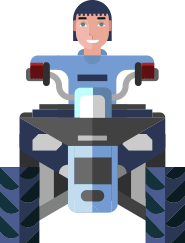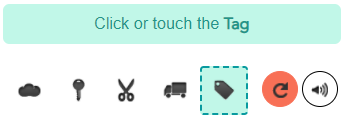Compare ATV Insurance Rates
Learn more about the factors that dictate your ATV insurance rates, compare top insurers, and save.
 Your information is secure.
Your information is secure. ATV
ATV is often overlooked, but the fact is, ATVs are associated with relatively high rates of injury. Before you decide to take a ride, take time to brush up on basic liability issues.

Why is ATV liability important?
Many people assume they won't need ATV liability insurance if they only allow friends or family members to drive. Unfortunately, accidents happen, and you may inadvertently injure or cause damage to someone else.
Speaking of family members, do not automatically assume the younger drivers in your family are covered while driving or riding an ATV. Many ATV policies exclude youthful operators.
ATV drivers also need liability insurance in the event they destroy property. Even a simple ATV accident can cause property damage for which the operator of the ATV will be responsible.




Do I need insurance for my ATV?
It depends—every state has different insurance requirements. As an ATV owner, you should get familiar with your state's liability insurance requirements for operating your ATV on public roads and highways. This will help protect your investment.
You may want to consider purchasing ATV insurance for a few reasons:
ATVs have a high theft rate.
If you ride an ATV off your property or trailer your ATV to another location, your homeowners insurance may not cover your ATV.
If you use your ATV in a state-owned or public park, ATV insurance may be required
ATV Insurance Coverage
Wheeling surely gets your heart racing, but what does ATV insurance from Goods Insured Options get you?
Well, it may not get your blood pumping in quite the same way as hopping on your four-wheeler, but it does help you out if something should go wrong while outing in the outdoor or mudding.







Here is a small rundown of the coverages included in our insurer’s options ATV policy:
ATV/UTV insurance can cover the injuries or damages, you’re liable for and repairs to your vehicle with many of the insurance carrier.
- Collision coverage – pays for covered damage to your ATV when it hits, or is hit by, another vehicle or other object. This coverage is available with a multiple deductible options.
- Property damage liability coverage – insures you against certain damages caused to someone else's property while operating your ATV and in most cases, provides you with a legal defense for such claims if another party files a lawsuit against you.
- Bodily injury liability coverage – insures you against certain damages if you injure or kill someone while operating your ATV and in most cases, provides you with a legal defense if another party in the accident files a lawsuit against you.
- Comprehensive physical damage coverage – pays for covered losses resulting from incidents other than collision - such as theft, fire or vandalism. This coverage is available with a $500 or $1,000 deductible and is limited to damage that affects the structure or safe operation of the vehicle.
- Medical payments coverage – in most states you can select medical coverage for yourself and your passengers.
- Uninsured/Underinsured motorists coverage – insures you against certain damages in the event of an accident that occurs on a public road or highway where you are struck by someone with no insurance coverage or limits that are lower than yours. The uninsured vehicle must be a vehicle that is designed to be insured and registered for use on a public road or highway (such as a car, truck, or motorcycle).
Avoiding ATV Liability Risks
While you cannot prevent unforeseen accidents, you can take precautionary measures to reduce ATV liability risks. Here are a few examples:
Obey the published weight limits and do not attempt to haul extra cargo
Many ATVs are made for one person and should not be driven with passengers
Make sure youthful operators are driving the proper sized ATV
Never operate an ATV under the influence of drugs or alcohol


Is ATV insurance required?
Not all states mandate insurance on your ATV or UTV, but places where you ride it might – like RV trails and public parks. Also, if you’re financing your vehicle, some lenders will require comprehensive and collision coverage.
Is your four-wheeler covered by your home insurance policy?
If you did not know Home insurance typically covers your ATV for scenarios on your property only in case you have a big multiple acre property, which means you’ll need a separate ATV/UTV policy for accidents that occur away from home.


How much is ATV/UTV insurance?
Your price depends on many factors, including your vehicle’s make, model and location. Your age and driving history also help determine your rate.
What type of ATV, UTV, and brands can be insured?
We insure nearly all popular makes and models, including but not limited to Polaris, Can-Am (BRP), Honda, Yamaha, and Kawasaki.
ATV Storage And Maintenance
Few things are worse than buying a brand new ATV, using it for the season and then putting it into storage only to find the carburetor clogged early the next spring; or worse—not finding the ATV at all because it was stolen!
Use this handy ATV storage and maintenance checklist to make sure you are properly prepared for a season of fun and safety.
Select the right spot. If possible, store your ATV in the garage along with your car. Be sure to lock and cover it to deter the risk of theft. Always remember to include ATV theft insurance when calling your GEICO representative for an all terrain vehicle insurance quote because regular homeowners policies rarely cover the cost of a stolen ATV.
Drain the fuel, change the oil and install a new filter while inspecting for leaks. Avoid repair bills by making sure the engine is properly maintained for the winter.
Wash and lubricate the entire ATV. Remove all excess grime and dirt, then lubricate hardware to avoid rust.
Take a photo of the ATV to document any repairs so you can keep track of your ATV's history.
Check protective gear. Replace damaged or outgrown helmets, gloves and other gear at the end of each season.
Inspect tires and wheels. Make sure you're following the manufacturer's recommended levels of pressure without over- or under-inflating. Ensure the wheels and tires are in good condition. Replace worn tires if needed, make sure wheel nuts are properly tightened and check for worn-out bearings.
Inspect the brakes, foot shifter, throttle and cables. Pay special attention to smooth operation and make sure breaks work properly.
Check to see if lights, horn and other miscellaneous functions are in good working condition.



















